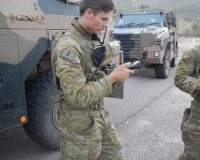According to our capstone doctrine, there are two pillars of our Army’s approach to warfighting; the Manoeuvrist Approach and Mission Command. Enabling both, particularly at the tactical level, are the following principles:
- Operational tempo
- Reconnaissance pull
- Combined arms teams
- Focus friendly action on enemy Centre of Gravity
- Achieving surprise
- Identifying and prioritising a Main Effort
- Utilising deception
- Application of joint fires and effects
In 2013, I was Brigade Major for 3 Brigade undertaking HAMEL/TALISMAN SABRE against Major General Bilton’s Opposing Force (OPFOR). We were an analogue organisation – completely reliant on voice communications for all but our Artillery Battlespace Management System.
In my opinion, 3 Brigade did some things well on HAMEL/TALISMAN SABRE 2013. It also learned a great deal – and often the hard way. Analogue communications were tough. I estimate some 90% of the Formation Headquarters’ time and energy was dedicated to simply confirming dispositions and confirming orders were received. Invariably, these orders were not received, or if they were, they were received too late.

Rick Astley's 'Never Gonna Give You Up' album
It was the first time in my career I witnessed routine OPFOR interference in our communications (most often we interfere in our own communications integrity). I distinctly recall trying to assist the Commander’s direction of the final Formation attack with Rick Astley’s 1987 megahit ‘Never Gonna Give You Up’ rudely interjecting on the Command Net. I never want to hear that song again.
While some things were done well by 3 Brigade on this Exercise, it would be fair to say it never, as a fighting formation, consistently achieved the warfighting pillars – nor the principles underpinning them – post H hour. This is not to say we did not do our utmost to achieve them. I am not certain I have ever been as exhausted, physically, mentally and emotionally as that exercise. Yet, it would be imprudent to conclude we truly achieved the manoeuvrist approach, mission command and their underlying criteria.
When it did occur, it was short-lived, and probably, only by chance. Our inability to achieve these warfighting pillars headlined the after action review and lessons learned – one of which (and a common fault according to successive Combat Training Centre Trend publications) was the Formation never really fought the enemy. That is perceiving, then acting on, fleeting tactical opportunity and shielding against actual or emergent risk. Rather, exclusively, yet fervently, we fought our own plan. I suppose this is an understandable approach if one is never certain what is actually going on.
3 Brigade returned to the ring, gloves off, for HAMEL 2014. Some, perhaps unkindly, contend it was their (and my) retest! Between 2013 and 2014, 3 Brigade digitised to mounted combat team level. While mounted and digitally networked, our ability to achieve the warfighting pillars was profoundly better than 12 months prior. Suddenly, very little of the Headquarters’ time was spent confirming dispositions and verifying orders/FRAGOs (fragmentary orders) were received – and understood (HUA!). Our mounted battle management system (BMS)/digital backbone allowed us to devote 90% of our time on planning, executing, ensuring the warfighting pillars were consistently, and methodically, achieved.
Yet, as soon as the Formation’s combat teams dismounted, which they frequently had to, particularly in the penultimate actions, compelled by the enemy or by the terrain, the Headquarters returned to the dark command and control (C2) vacuum, the information black hole, of 2013. In comms red, no one can hear you scream…
Once again, the Headquarters dedicated 90% of its time to simply confirming dispositions and confirming receipt of orders/FRAGOs. Our ability to achieve the manoevurist approach and mission command – taking advantage of opportunity and shielding risk perceived at combat team and below - was unhinged.
Fast forward to 2017.
In July 2017, I commanded the 1st Battalion Royal Australian Regiment (1 RAR) Ready Battle Group on HAMEL/TALISMAN SABRE. Due to the paucity of vehicles, we were rarely mounted below combat team headquarters. Accordingly, the Brigade Commander employed the Battle Group as his discrete dismounted force, on radio silence, to infiltrate and both surprise and offend the enemy in complex terrain.
The conclusion of HAMEL/TALISMAN SABRE 2017 was fought on bastard terrain against a determined enemy, who had selected such geography, like any enemy would to dislocate and disrupt our armour – and other assets that offered us a firepower, mobility, protection and networked advantage.
The Formation’s intent to lead/penetrate with its Armoured Battlegroup was dislocated by the determined 1 Brigade OPFOR, who destroyed the lead tank in their obstacle belt. Voice communications were contested in a manner I had not seen to that point – although Rick Astley was mercifully left out of the playlist. 1 and 2 RAR, the dismounted Battlegroup ‘finishers’ for the Combat Brigade attack, who had infiltrated dismounted, via complex terrain at night, to maximise surprise, tempo, deception – the manoeuvrist approach – found themselves in a two-way C2 void. Despite everyone’s best intentions and herculean efforts to fight the BLUEFOR (blue force) plan, the attack resulted in an inconsequential melee.
Rarely have I experienced, so intensely, the chaos, friction and uncertainty of war as on that day. Following 2013 and 2014, I also appreciated, for the first time, what it may be like to act in a TV soapie: every year, same script, different actors.
Based on personal experience and the study of war, I believe that any enemy, peer or asymmetric, will always seek to dislocate our critical capabilities; namely our vehicles which afford us a firepower, mobility, protection and networked advantage. Accepting this premise, I contend that unless we digitise our dismounted F Echelon (Fighting Echelon), ensuring they remain connected to the network, we will simply be unable to realise our warfighting pillars – and their underpinning principles. If we do, it will likely be by chance, not by design – and fleetingly.
Of course, we have attempted to do this before. The battle management system – dismounted (BMS-D) proposition offered early this decade was unacceptable in its form and design – even if the intent was spot on. Technology – including the advent of weapons integrated (WIN)-BMS, which promises an exponential improvement in our ability to optimise our mounted combined arms teams, our most potent configuration – and our own lessons learned from a leading, annual force generation (FORGEN) cycle/road to HAMEL, has come a long way in a relatively short period of time. Indeed, soldiers and junior leaders from 3 Brigade who recently tested the emerging BMS-D hardware and software concluded the form and design is ready – and now.

I believe BMS-D offers our Army a circuit breaker in being able to truly realise our warfighting pillars, methodically and responsively, whether we fight mounted or dismounted. It will unhinge the enemy’s ability to dislocate. It is the missing link to enable true tempo and reconnaissance pull, optimise combined arms teams (mounted/dismounted), allow us to rapidly perceive and target the enemy’s Centre of Gravity (down to platoon/troop and section levels), attain surprise more readily, better inform commitment of Main Effort and Reserves, enable deception at all levels – as well as allow all to judge the success of such deception, and maximise joint fires and effects. Realising these principles will enable true application of the manoeuvrist approach and mission command throughout our fighting Formations.
The missing link is available now. Accordingly, it should be pursued by our Army as a priority.









